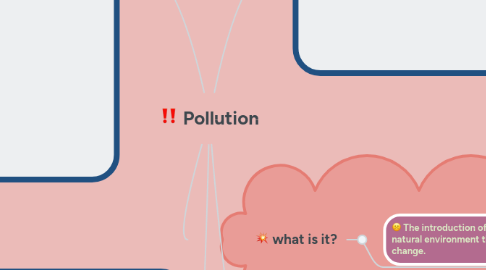
1. Forms of pollution
1.1. Air pollution
1.1.1. Common gaseous pollutants include carbon monoxide, sulfur dioxide and chlorofluorocarbons.
1.2. Electromagnetic pollution
1.2.1. Like radio waves, etc, that people are constantly exposed at, especially in large cities.
1.3. Light pollution
1.3.1. Includes light trespass, over-illumination and astronomical interference.
1.4. Littering
1.4.1. The criminal throwing of inappropriate man-made objects, unremoved, onto public and private properties.
1.5. Noise pollution
1.5.1. Which encompasses roadway noise, aircraft noise, industrial noise as well as high-intensity sonar.
1.6. Water pollution
1.6.1. The contamination of water bodies, usually as a result of human activities, in such a manner that negatively affects its legitimate uses.
2. Effects
2.1. Human health
2.1.1. Ozone pollution can cause respiratory disease, cardiovascular disease, throat inflammation, chest pain, and congestion.
2.1.2. Water pollution causes approximately 14,000 deaths per day, mostly due to contamination of drinking water by untreated sewage in developing countries.
2.1.3. Oil spills can cause skin irritations and rashes.
2.1.4. Noise pollution induces hearing loss, high blood pressure, stress, and sleep disturbance.
2.2. Environment
2.2.1. Carbon dioxide emissions cause ocean acidification, the ongoing decrease in the pH of the Earth's oceans as CO 2 becomes dissolved.
2.2.2. The emission of greenhouse gases leads to global warming which affects ecosystems in many ways.
2.2.3. Soil can become infertile and unsuitable for plants. This will affect other organisms in the food web.
3. what is it?
3.1. The introduction of contaminants into the natural environment that cause adverse change.
4. Sources and causes
4.1. Natural sources
4.1.1. The consequence of a natural disaster
4.1.1.1. For example, hurricanes often involve water contamination from sewage, and petrochemical spills from ruptured boats or automobiles.
4.2. Human-made sources
4.2.1. Globally human-made pollutants from combustion, construction, mining, agriculture and warfare are increasingly significant in the air pollution equation.
4.2.2. Motor vehicle emissions are one of the leading causes of air pollution.
4.2.2.1. In the case of noise pollution the dominant source class is the motor vehicle, producing about ninety percent of all unwanted noise worldwide.
5. Pollution control
5.1. Pollution control is a term used in environmental management. It means the control of emissions and effluents into air, water or soil.
5.1.1. Practices
5.1.1.1. 1.Recycling 2.Reusing 3.Mitigating 4.Preventing 5.Compost
5.1.2. Pollution control devices
5.1.2.1. Air pollution control 1.Thermal oxidizer
5.1.2.2. Dust collection systems 1.Baghouses 2.Cyclones
5.1.2.3. Scrubbers 1.Baffle spray scrubber 2.Cyclonic spray scrubber
5.1.2.4. Industrial wastewater treatment 1.API oil-water separators 2.Biofilters
